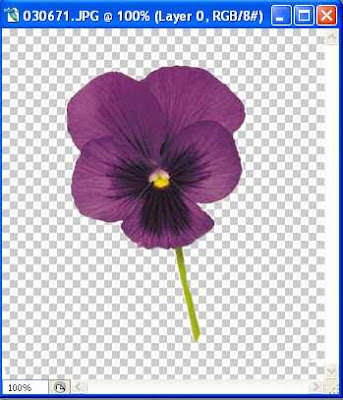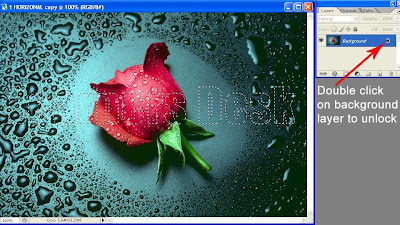ZOOM (Z) AND HAND (H) TOOLS :
In this tutorial we are going to learn about Zoom and Hand Tools together. Because we can work with Hand tool only in Zoom mode.
Sometimes we will have to observe some objects very closely to have a look at specific areas to know clearly what is there.Like, if you are working with little facial blemishes, then you will need to observe the range of blemishes. so to observe blemishes clearly you should work with zoom mode.
Hence to observe any error or anything in an image in a pixel wise view we need to work with Zoom in mode.
At the end of this tutorial you will be completed with Zoom in and Zoom out modes, working with Hand tool and some Keyboard shortcuts.
1. First open any image. Here I took a Flower. Now I want to select the flower. To do this choose any selection tool and draw an outline around the flower. Here I have chosen pen tool for selection.
But we are not able to select flower edges properly in Normal mode.
2. To select edges of the flower properly with pixel wise we need to work with Zoom in mode. To do this select Zoom tool from tools panel or you can use keyboard short cuts to work with Zoom tool which will be explained at the end of tutorial.
NOTE: After selecting Zoom tool, you will find " + " and " - " symbols in options bar. " + " is for zoom in and " - " is for zoom out.
3. After selecting Zoom tool a " + " symbol cursor appears. Then click(click multiple times to zoom the image more) on image to Zoom in. Now you can see the image in a pixels wise view clearly. Then select the edges of image properly with any selection tool.
HAND TOOL:
4. While working with Zoom in mode, we will have to move or adjust the image for selecting the image properly. Hence to move the image around the work space we need to use Hand tool.
To do this select Hand tool form Tools Panel or hold down SPACEBAR and when cursor turns to a hand symbol click on the image and drag the image according to your need and select the image properly.
5. Here I have selected Flower properly by working with Zoom in mode and by adjusting the image with Hand tool.
KEYBOARD SHORTCUTS:
Press letter " Z " in keyboard. Then cursor turns to " + " symbol. Now click on the image to Zoom in. Hold down " ALT " key and when cursor turns to " - " symbol, click mouse left button on the image to Zoom out.
Hold down "CTRL + SPACEBAR" and click on the image to Zoom in. Hold down " ALT + SPACEBAR " and click on the image to Zoom out.
Press "CTRL + +" in keyboard to Zoom in. Press "CTRL + - " in keyboard to Zoom out.
PLEASE LEAVE YOUR COMMENTS
In this tutorial we are going to learn about Zoom and Hand Tools together. Because we can work with Hand tool only in Zoom mode.
Sometimes we will have to observe some objects very closely to have a look at specific areas to know clearly what is there.Like, if you are working with little facial blemishes, then you will need to observe the range of blemishes. so to observe blemishes clearly you should work with zoom mode.
Hence to observe any error or anything in an image in a pixel wise view we need to work with Zoom in mode.
At the end of this tutorial you will be completed with Zoom in and Zoom out modes, working with Hand tool and some Keyboard shortcuts.
1. First open any image. Here I took a Flower. Now I want to select the flower. To do this choose any selection tool and draw an outline around the flower. Here I have chosen pen tool for selection.
But we are not able to select flower edges properly in Normal mode.
2. To select edges of the flower properly with pixel wise we need to work with Zoom in mode. To do this select Zoom tool from tools panel or you can use keyboard short cuts to work with Zoom tool which will be explained at the end of tutorial.
NOTE: After selecting Zoom tool, you will find " + " and " - " symbols in options bar. " + " is for zoom in and " - " is for zoom out.
3. After selecting Zoom tool a " + " symbol cursor appears. Then click(click multiple times to zoom the image more) on image to Zoom in. Now you can see the image in a pixels wise view clearly. Then select the edges of image properly with any selection tool.
HAND TOOL:
4. While working with Zoom in mode, we will have to move or adjust the image for selecting the image properly. Hence to move the image around the work space we need to use Hand tool.
To do this select Hand tool form Tools Panel or hold down SPACEBAR and when cursor turns to a hand symbol click on the image and drag the image according to your need and select the image properly.
5. Here I have selected Flower properly by working with Zoom in mode and by adjusting the image with Hand tool.
KEYBOARD SHORTCUTS:
Press letter " Z " in keyboard. Then cursor turns to " + " symbol. Now click on the image to Zoom in. Hold down " ALT " key and when cursor turns to " - " symbol, click mouse left button on the image to Zoom out.
Hold down "CTRL + SPACEBAR" and click on the image to Zoom in. Hold down " ALT + SPACEBAR " and click on the image to Zoom out.
Press "CTRL + +" in keyboard to Zoom in. Press "CTRL + - " in keyboard to Zoom out.
PLEASE LEAVE YOUR COMMENTS


























































